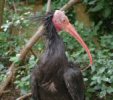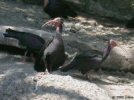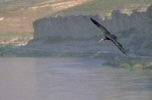Mangoverde :: World Bird Guide :: Ibises and Spoonbills :: Waldrapp Ibis
Waldrapp Ibis Geronticus eremita
Described by: Linnaeus (1758)
Alternate common name(s): Northern Bald Ibis, Hermit Ibis, Waldrapp, Bald Ibis
Old scientific name(s): None known by website authors
Photographs




Select thumbnail to view larger image - Place cursor over image for image information
Range
Nw. Africa; W. Arabian Peninsula;
Two populations;
Ex. restricted range; New colony located at Al Badia in the Palmyra desert of Syria, which is possibly the source of the birds occasionally observed in Arabia. Two breeding sites in Morocco: the main population in coastal and the Atlas Mountain region including the Souss Massa National Park (a 60km strip along the coast s. of the Souss River and Agadir and n. of the Massa River). The remainder of the population is at another coastal area 100km n. Tamri. One site that is irregularly used in Algeria (Boghari). Formerly at Birecik on the upper Euphrates River in s. Turkey (a small semi-captive flock still exists there) and Saudi Arabia.
The e. population formerly dispersed in ne. Africa during the winter to North Yemen, ex. e. Sudan, Ethiopia (Massawa/Asmara and Addis Ababa regions) and ex. nw. Somalia. The dispersal of the w. population is not well understood, but seems to be e. to Tunisia and s. to w. Algeria, Mauritania (?) and nw. Mali (?) (Lakes Takadji and Faguibine). Formerly bred in s. Germany, Switzerland, Austria and probably Greece.
Videos
No videos are available for this species
Sounds
No sounds are available for this species
References
Clements, James F. Birds of the World: A Checklist. Vista, CA: Ibis Publishing Company, 2000.
Comments/Errors
Please email with errors/comments on this page or to donate photos.
If there is no family list to the left, you may have arrived at this page from a direct link.
Please select "Mangoverde World Bird Guide" to view the entire bird site.







